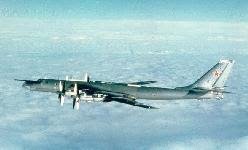TU-95 Bear H long-range bomber.
Given the growing frequency of training flights by Russian TU-95 “Bear” bombers, that long-expected run against the U.S. east coast appears all be inevitable. At this point, it’s not a matter of “if” the flight will occur, just only a question of “when.”
This recent AP story from Alaska offers some idea of how often Russian bombers have been flying against U.S. and/or NATO airspace. According to a spokesman for the Alaska region of NORAD (North American Aerospace Defense Command), there have been seven flights by Russian long-range bombers against U.S. and Canadian airspace so far this year, the most since the cold war.
The most recent occurred about two weeks ago (19 Sep), when two Russian bombers approached NORAD’s northern air defense boundary. At least five of the flights have been staged near the U.S. Aleutian Islands. In each case, approaching Russian bombers were met by American F-15s, or Canadian CF-18s. While the bomber sorties appear to be routine training missions, their growing frequency suggests a more assertive Russian military posture, as suggested in recent comments by Vladimir Putin. Increased flight activity by Bear and TU-160 Blackjack bombers followed Mr. Putin’s vow to resume long-range training missions that would carry them near western airspace.
Having demonstrated their ability to stage periodic flights near Alaska, Norway, Great Britain and northern Canada, the Russians will likely set their sights on the most provocative mission of all, a flight along the U.S. eastern seaboard, just outside our air defense intercept zone. While Bear crews haven’t flown that profile since the end of the Cold War, staging an “east coast run” would send a clear a signal about Mr. Putin’s plans for the Russian military–and Moscow’s increasingly chilly relations with the west.
At this point, no one is really sure why the Russians haven’t resurrected their “east coast” profile. In the past, one or two “Bears” would launch from their base in central Russia and fly north to the Kola Peninsula. Leaving Russian territory north of Murmansk, the bombers would turn south, heading past Norway and through the Greenland-Iceland-U.K. (GIUK) Gap, before flying parallel to the U.S. eastern seaboard. The long-distance missions ended with a landing in Cuba, where the Bears would remain for a few days before returning home.
There is some speculation that shortages of aviation gas in Cuba may be preventing an “east coast” mission by TU-95s. However, there are also reports that Venezuela is meeting Cuba’s energy needs, so reports of a “fuel shortage” may be overstated. A better explanation is that Mr. Putin is waiting for the “right moment” to stage the flight, ensuring maximum publicity for the mission and his more muscular defense policies. Other analysts suggest that Russia is waiting for the end of the Atlantic Hurricane season, to avoid having aircraft stranded or damaged by a storm threatening Cuba.
In any case, all signs still point to an “east coast” mission by Russian bombers before the end of the year. The good news, of course, is that the mission will not come as a surprise, and the Bears will be escorted throughout their journey by Norwegian, British and U.S. fighters. Our “cueing” for these flights remains quite good, as evidenced by the intercept of Russian bombers–outside western airspace–on every long-distance mission attempted this year.


